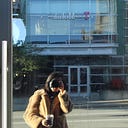CONFIGURATION 1
CONFIGURATION 2
MODULE 2:
CONFIGURATION 1:
For this configuration, I took the scored rectangle and connected the two pieces to form a diamond. I then took these pieces and I attached it evenly.
CONFIGURATION 2:
MODULE 3
CONFIGURATION 1:
The rule for this configuration was to connect the 60 degree angle and the 90 degree angle together.
CONFIGURATION 2:
The rule of this configuration was to connect the same angles of the triangles together. 90 degrees to 90 degrees// 30 degrees to 30 degrees// 60 degrees to 60 degrees.
4/19/20: Create 25–50 modules/ One configuration
I create modules in the shape of a circle and recreated the joints I made in the previous iteration. Within every column of circles, there was a rule the intersections followed. After, I built up more circles on top with the same rule of intersections.
FEEDBACK:
- The word “hang” is not as effective. Maybe use the word “climb”
- Try more of a dynamic structure, the configuration right now is stagnant and too tall for children to play in. Maybe tilted to the side or pyramid like?
- Think about how the person would climb up, think about the steps
- the circles are too opaque, more variety in the modules would help.
4/27/20
For this week I asked three people to describe what my space feels like. Here are their responses:
- PERSON 1: INTERACTIVE: Due to the many different colors found in the module, the child would be engaged while climbing up the form.
- PERSON 2: CHALLENGING: The way the modules are configured makes it look very difficult and dangerous for children to climb up. There are no ergonomic foot planks for the child to pull themselves up.
- PERSON 3: BRIGHT:Due to the colors intertwining together, the form creates a very bright space. Also considering that this form will be outdoors supports the brightness of this figure due to the reflection of the sunlight on the colors.
Something I want to fix for my next iteration is the use of craft. I’ve been using glued colored paper on these pieces, however, this method creates frayed edges and uneven coloring. I will try using paint for my next iteration.
IN-CLASS CRITIQUE:
- My module is too expected. Even though I have more than one module, it looks like I am experimenting with only one due to the way I am putting these pieces together. Explore a different variation in module configuration.
- My module has three different points of axes that I could use to my advantage. Experiment with different color combinations on these axes.
- Since my idea was having my configuration outdoors, experiment with outdoor lighting and thing about context as well.
FINAL MODEL
Why I changed my configuration:
There were many problems I noticed with my previous configuration. Not only was the configuration too expected and not engaging, the pieces were organized in a way that it was very hard for children to easily climb up the form. I wanted to try a different configuration for my final because I knew there was a better way I could express my word: climb.
The colors were chosen and placed so that when the child looks down from the top, he/she only sees warm colors while seeing the form straight on will lead them to seeing only cool colors. The sides of the figures were painted uniformly based on the axis the circles faced, pastel pink and purple. I hoped to create an engaging experience through the color choices of the different axes and my new configuration allows climbing to be more accessible as well.
